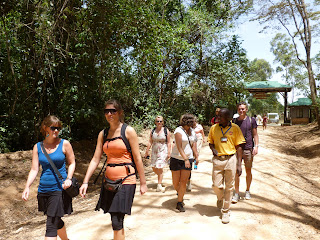On this past Saturday we visited one of the last stands of tropical rainforest in East Africa. This is a highland tropical forest, so it is not quite as wet and lush as you would see in the lowlands. In lowland rain forests like the Amazon or the Congo it rains pretty much all year. Where we are there are distinct wet and dry seasons, which means the forest is not quite as dense as you would get in the lowlands like the Amazon. We saw a bunch of monkeys cavorting in the trees, and heard a lot of birds, though we didn't see as many as I had hoped. We were a large group kind of lumbering through the forest, so any wildlife got pretty spooked quickly. There is a primary growth forest (the old stuff) and then secondary growth where the forest has been cut several years ago. They have a lot of problems with people coming into the forest and cutting trees for wood or using wood for charcoal burning, which is a huge problem for the forests throughout Africa. Kakamega, then, has a lot of threats. If was very pretty, though warm that day, so it was a long day in the forest.
The entry gate to the forest.
Our group heading out. I don't think anyone thought we would be hiking for six hours!
Entering the forest. The paths were wide, but not well marked. It's good we had a guide!
One of the Swedish guys climbing around. This is the old growth forest here, with large trees.
This is a view up into the tree canopy. Though it is old growth, you can see it's not as dense as what you would get in the Congo. Also, it's just not as wet.
This is a tropical giant tree, being attacked by various parasite type plants.
Our group making our way through the forest. There is Evan.
There we are in front of a big tree!
Evan in front of another big tree.
Another view of the tree canopy. I just finished reading Tarzan of the Apes, and he would sleep in the crook of the branches of tropical giants. You can see the type of trees Burroughs was talking about here.
This is the root system of a tropical giant. They have to branch out like that to support the tremendous height of the tree.
This is our group at the base of a tropical tree. You can imagine how much noise we were making stomping through the forest!
This was our guide, Patrick was his name. Very nice, very knowledgeable of the forest.
This is a vine system that extends up into the canopy. You can imagine Tarzan scampering up this to get to his tree house!
This is Evan in the vines.
This is a view from a hill in the forest, with the forest stretched out below. This is looking to the east. The guide said this is a great place to watch the sun come up in the morning. At one time this type of forest covered much of east Africa, so early hominids would have walked through miles and miles of this type of landscape. Pretty amazing to think about!
Another view of the forest below. That is the Nandi Escarpement in the background, one of the many features of the rift valley region, where plate tectonics is at work!
This is me, with the forest in the background, just standing.
This is a jumping Danish girl. I just threw this one in.
There are open areas in the forest where antelope apparently come out to play. We saw none, because it was hot in the middle of the day and we were quite noisy.
The last part of our journey was to a very pleasant waterfall.
Evan and I in front of the waterfall.
Evan by himself, just because I like the picture. Apparently this whole area gets filled up with water during the height of the rainy season, which is coming soon....
There are little shambas like this on the edge of the forest. No electricity or running water. Lots of cows and some goats. It was right around here that some older guys offered me a taste of homemade African whiskey. At first I said no thanks, then thought about it and said, why not? I took a sip. Quite strong!
These were some kids herding cows home in the afternoon. They were having a good time laughing at the mzungus tromping down the road, leaving the forest behind.
Couldn't resist the chickens crossing the road....
One last view of a traditional shamba. These people work very hard in the fields, and have few luxuries. A very traditional way of life on the edge of one of the last stands of rainforest in East Africa.



























No comments:
Post a Comment